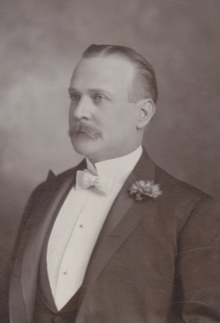Albert Bilicke
Albert Clay Bilicke (born June 22, 1861 in Coos County , Oregon , USA , † May 7, 1915 in the Atlantic Ocean off the Irish coast) was an American hotel owner , real estate agent , investor and building contractor , primarily in the US state of California played a leading role in the construction and hotel industries.
Career
After attending Heald's Business School in San Francisco, Albert Bilicke moved to Arizona at the age of 17, where he entered the hotel business. Together with his father, he founded the Cosmopolitan Hotel in Florence , initially only working as an employee. The family's hotel business flourished and when another Cosmopolitan Hotel opened in his hometown of Tombstone , he became its manager. After the death of his father, Bilicke succeeded him as chairman of the mining company Pedro Consolidated Mining Company at the age of 21.
In 1885 he went to California, where he first opened hotels in Santa Rosa , Modesto (Ross House) and Santa Cruz (Pacific Ocean House). In 1891 Bilicke moved to Los Angeles. There he built and managed the elegant Hollenbeck Hotel in 1893. In 1904, Bilicke began his biggest project: planning the Alexandria Hotel. It opened the following year and quickly became the most prestigious address in Los Angeles. Bilicke also invested in real estate in Kansas City , Missouri , which made him a millionaire.
In addition to his work as a hotel operator, Albert Bilicke also made a name for himself as a building contractor in the southeastern United States. Together with the Bautycoon Robert Rowan (1875-1918) he founded the Bilicke-Rowan Fireproof Building Company, which bought land and built hotels and office buildings on it. The company became very successful and had several offshoots over the years, such as the Bilicke-Rowan Annex Company, the Bilicke-Rowan Commercial Building Company, the Century Building Company, the Central Fireproof Building Company and the Commercial Fireproof Building Company.
Family and personal life
Bilicke was the son of the German immigrants Charles Gustavus Bilicke (1831-1896) and Caroline Sigismund (1826-1902). Together with his sister Louise Emma Bilicke he grew up in Tombstone ( Arizona ). On September 10, 1900, he married Gladys Huff (1865-1943) from Illinois , with whom he had three children: Albert Constant (1902-1995), Nancy Caroline (1903-1941) and Carl Archibald (1907-1992). Bilicke and his family lived on a large estate on Monterey Boulevard in South Pasadena , California, whose extensive orange groves sloped into terraces to the sea. He and his wife were active in the social life of the South Pasadena community.
Bilicke was an active athlete in his spare time and joined several organizations such as the Athletic and Annandale Golf Club in Los Angeles, the Valley Hunt Club in Pasadena, and the Southern California Auto Club. He was also a member of the Freemasons and the Knights Templar .
On July 17, 1923, his daughter married in Paris Henry D. DeRoulet (1900–1979), heir to a property in Los Angeles. They had a daughter, Joan Bilicke DeRoulet Schmoele (1925-1995).
death
After Bilicke had undergone serious abdominal surgery in the spring of 1915, his surgeons advised him to take a short, relaxing vacation trip to recover from the exertion. But he decided to go on an extended trip and traveled to New York with his wife . There the couple spontaneously decided to cross the Atlantic followed by a stay in England. They booked a first class passage (ticket no. 19841) on the British luxury steamer RMS Lusitania , which left New York on May 1 and was supposed to arrive in Liverpool seven days later . In the days before departure, he sent several postcards to friends who, because of the naval war, immediately advised him not to take the Lusitania . The couple lived in B-48, a luxury suite with a private bathroom.
On May 7, 1915, the ship, which had almost 2,000 people on board, was sunk off the south coast of Ireland by a German submarine, as the Germans suspected weapons and contraband for enemy England on board. Albert Bilicke and his wife got into a lifeboat that overturned when it was lowered and threw its occupants into the sea. Albert Bilicke was killed in the sinking. Gladys Bilicke managed to hold on to wreckage until she was rescued hours later. In Queenstown , Ireland , where the survivors were being taken, Gladys searched the mortuaries for her husband in vain ; his body was never found.
In Los Angeles, Gladys Bilicke erected a memorial to her late husband. Like many other survivors of the Lusitania Incident, she sued the German Reich and received $ 50,000 in damages in 1924, as well as an additional $ 30,000 for each of her children.
swell
- http://freepages.genealogy.rootsweb.ancestry.com/~npmelton/labili.htm
- Mr. Albert Clay Bilicke - South Pasadena History ( Memento October 6, 2007 in the Internet Archive )
- http://untreaty.un.org/cod/riaa/cases/vol_VII/263-265.pdf (PDF file; 94 kB)
- Mr. Albert Clay Bilicke, Saloon Class Passenger ( Memento from January 3, 2007 in the Internet Archive )
- Read We Forget Part 2: As The Lusitania Went Down
| personal data | |
|---|---|
| SURNAME | Bilicke, Albert |
| ALTERNATIVE NAMES | Bilicke, Albert Clay (full name) |
| BRIEF DESCRIPTION | American hotel owner, real estate agent, investor, and contractor |
| DATE OF BIRTH | June 22, 1861 |
| PLACE OF BIRTH | Coos County , Oregon , USA |
| DATE OF DEATH | May 7, 1915 |
| Place of death | Atlantic off the Irish coast |
